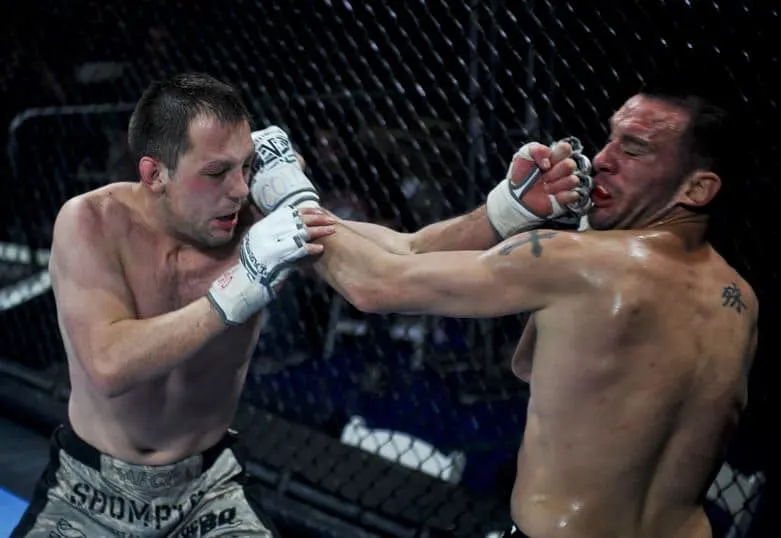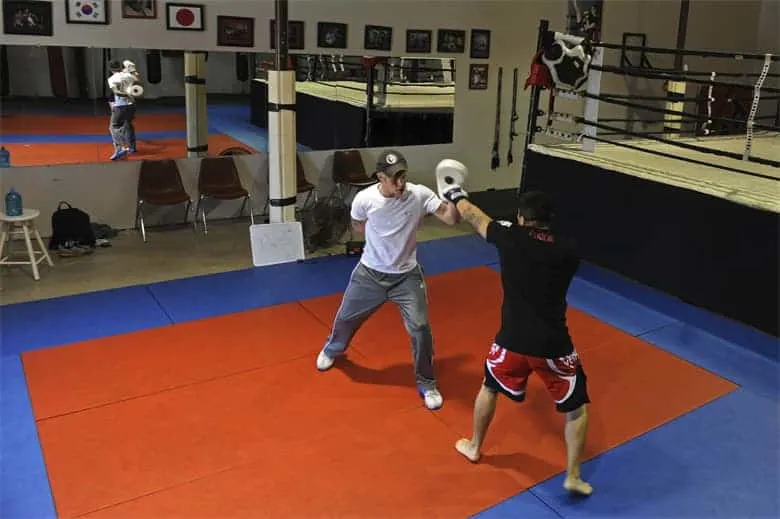
With the popularity of Mixed Martial Arts today, especially the UFC, many are wanting to get involved in the sport. Of course, MMA literally involves several martial arts, all mixed together to see who the best fighter actually is.
Due to MMA becoming likely the second biggest sport in the world, only behind football, we can see why you want to become a professional fighter like most of us wanted to be a professional baseball or football player growing up.
If you ask us, all you need to do to become a professional fighter for an organization like UFC or anywhere else is to know where to start.
This article will be your personal guideline, showing you the best concepts and ideas available to us at this present time. Let’s get started!
When Is The good AGE To Start Training?
Ideally, you want to begin getting into MMA or Martial Arts training as soon as you can.
The reason for this is that the human body can only take so much. We age like normal and with that comes changes, meaning regardless of what we do…these changes will occur. THEN you add in fighting on top of that.
While getting involved in other sports in your mid to late 20s is not a bad thing, in order to compete at the highest level, you need to start younger. Keep in mind that many of these people will have years…sometimes a decade of training and be at the same age as you.
A very famous and talented fighter like Connor Mcgregor started boxing at 12 years old and later started training in MMA. McGregor, at the age of 18, has made his mixed martial arts debut in an amateur fight won easily. After that fight, he turned professional. In his case, it took him the total of 6 years.
You need to be at least 18 to be a professional fighter to participate in full-contact fights. Therefore, mathematically, the best age to start MMA is when your age is around 14 – 16 years of old IF you want to compete as early as 18 years old. There are Junior MMA events where there is No head Contact and semi-contact to the body those who aren’t 18 years of old.
Therefore, getting in on things quicker is massively important to become a professional fighter. Otherwise, you can train MMA regardless of your age since MMA is an excellent workout system.
How long does it take to be a professional MMA fighter?
There’s no exact amount of time it takes to become a professional fighter. Everyone’s learning aptitude varies. But you need to train approximately at least minimum of 2 years on a regular basis, 5 days a week. After that you can compete in amateur fights to see how well you do to evaluate your level against other fighters to determine whether you are ready to become a professional fighter or need additional training to turn professional.
Thus if you are talented, you can turn professional only after one amateur fight just like Connor McGregor did.
How Much Money Professional MMA Fighters Make?
There’s no universal pay scale for all fighters as each fighter’s pay is based on the terms of the contract that each fighter signed. The amount of money each fighter makes is mainly determined by his/her fight record and popularity.
For this reason, two different fighters with the exact same fight records do not necessarily make same amount of money. Top fighters also receive pay-per-view cuts on top of their base pay. The exact amount of these pay-per-view cuts are not published to the public as only the base pay is published to the public.
The best way to get a general idea as to how much money professional MMA fighters make is to look at the list of fighters’ payouts. Let’s look at the two major MMA promotions’ payouts. Click on the fighter’s name to see their current MMA record which has a direct correlation with their pay.
| Bellator | UFC 249 (Main Card) |
| Cris Cyborg ($250,000 + no win bonus = $250,000) Highest paid | Tony Ferguson: $500,000 (Highest paid) |
| Sergio Pettis ($30,000 + $30,000 win bonus = $60,000) | Alexey Oleinik: $160,000 |
| Emilee King ($3,000 + $3,000 win bonus = $6,000) | Sam Alvey: $65,000 |
The Six Fundamental Components of MMA training:
The main things to know about in MMA are as follows: Striking, Clinch, Groundwork, Submissions, Conditioning, and Strength.
The last two are more so revolving around specific body needs. However, while speed and agility are useful along with them…conditioning and strength mean more.
Conditioning is important because it helps you keep going well into a fight.
Strength is huge because it allows you to pick up and move someone without expelling as much. You’re prepared to handle a load, so moving them needs to be easy from a strength standpoint.
Do I Need To Be a Martial Artist To be a Professional Fighter?
The quick answer is no, but it massively helps if you know a style or multiple styles well. Every major professional fighter has one main style they trained in, but this does not always have to be a martial art. Both Boxing and Wrestling are not “technically” martial arts, but they are often counted among them by pro-fighters due to having a lot of the same disciplines.
That being said, there are some well-known MMA fighters with little or no martial arts backgrounds.
Why You Should Avoid Taking Two Similar Martial Arts
If you are going to get into certain martial arts, you want to do your best to spread them out as much as possible. For example, things like Judo, Sambo, and Wrestling often teach the same things. While they do it differently, it is not worth knowing all three when the basics and even part of the throws are heavily similar.
You also want to be careful that when you invest time in a martial art, you’re not taking one that will mix up many styles if you want just the one. For example, Japanese Jiu-Jitsu a.k.a Ju-jitsu or just regular Jiu-Jitsu) is a hybrid martial art that includes various strikes, grappling, and submission techniques. However, along with regular Jiu-Jitsu techniques, it actually teaches versions from other martial arts too. This is why it’s given the hybrid description.
Therefore, you would not take Ju-jitsu while also taking another martial art because Ju-jitsu might cross-reference techniques from other martial arts unless you wanted to get specific.
That is where it differs from Brazilian Jiu-Jitsu, as BJJ *ONLY* teaches BJJ techniques. This includes mostly grappling and submissions as well as some (but very little) clinch material.
The same can be said for Taekwondo and Karate. They are different in origin and discipline but both teach striking, even have similar versions of specific strikes. This is why you do not need to know both because you’ll learn next to nothing new that will be of use to you in the striking field. The only reason to do so is if you just want to know how that specific Martial Art does things.
This differs, however, from Muay Thai. Known as the “art of eight limbs,” it’s known for the notable and multiple striking concepts it teaches along with the infamous clinch work. However, depending on who you train with, you’ll also learn some submissions. Specifically, those that can be performed out of the clinch (i.e. standing figure four arm lock, standing kimura, standing guillotine)
Therefore, it differs enough to learn one of the other striking Martial Arts while also learning Muay Thai. There will be more than enough new and useful information.
Which Martial Art(s) is the best for MMA?
Whatever style martial art you choose to train in, you need to choose an art that focuses on striking, and choose another art that focuses on groundwork as these two different skills are the most fundamental part of MMA fighting.
When it comes to striking discipline, Muay Thai or Boxing is widely regarded as the most effective striking-based martial art for MMA. At the same time you have some professional fighters that train in full contact Karate to hone their striking skills.
With striking discipline, you have a variety of choice such as Karate or Savate and not just limited to Muay Thai or Boxing if you just aren’t interested in learning Muay Thai or Boxing.
When it comes to ground fighting, though, learning BJJ is NOT an option, it’s a requirement.
You can’t succeed as a professional fighter without learning BJJ as BJJ is the most effective art for the ground game. Even if you have a strong background in college wrestling which is another ground fighting style, you still have to learn how to defend against BJJ moves.
Fitness & Nutrition:
It is not only needed to be healthy in your own life but you especially want to do this as a fighter. For one reason, you need to do this well in order to always make weight. This can be a real problem for some people to do, so learn how to eat right sooner rather than later. This falls under things like nutrition, which many places also teach alongside MMA or Martial Arts. To read about the MMA diet on a budget, check out this article, “MMA Diet On A Budget To Improve Performance.”
Proper fitness is important too, This pretty much involves you putting a body together that properly connects with your specific style. If that means strength and conditioning like we mentioned the wrestlers having, then you need to develop this well. Always make your body connect well from an overall fitness level. However, you also want to always give primary attention to the sections of your body most used in your style too.
Find A Reputable Gym
This can be a bit difficult to do, as MMA Gyms that train specifically in just MMA content are rare to find. They are popping up more and more around the world but it’s nowhere near as easy to find as specific martial arts gyms. This is why we’d recommend you look into MMA gyms, but the best way to know they are worth your time is if you find good credentials in the instructors.
Make sure you notice we did not say “instructor” but rather “instructors.” No proper MMA gym will only have one trainer because even top professional fighters will tell you that they aren’t the best at everything. Even some of the greatest instructors have specific things they do well and use others to teach the stuff they do not.
These same instructors will help you pick the right gear or even offer it to you as part of the price you pay to use them. Gear can be important in many martial arts but especially in MMA.
You also want to look for credentials or certifications. For example, proper instructors MUST be a 1st-degree black belt or higher in their specific martial art. Ideally, you’ll want a 3rd Dan or 3rd-Degree Black Belt. However, black belt and higher can teach basics. While Teaching Certifications are nice to see, they are not actually required in most countries for Martial Arts Instructors. Many get them anyway just to be 100% legitimate.
It’s also good if the gym is a member of one or more specific leagues or organizations. For example, the International Brazilian Jiu-Jitsu Federation (IBJJF) or the United States Muay Thai Federation (USMF).
One of Top MMA Gyms in the U.S.:
By far the best way to become a professional fighter is to sign up with one of the prestigious MMA gyms if there’s one near you. These prestigious MMA gyms are known to produce one of the top fighters.
As a result these gyms can guide you better than anyone else to become a professional fighter and help you sign up with a top MMA organization because they already have access to top MMA promoters.
The top MMA gyms around the world are actually open to the public. However, whenever a top professional fighter comes in to train, they might close the gym for them or bring them in at specific hours to avoid the public. Usually, they only do this for people that the gym specifically sponsors. Many UFC Fighters have opened their own gym or invest in a gym they specifically liked.
For example, former UFC Fighter Brandon Vera’s gym, known as Alliance MMA, is fantastic. Vera started it in 2007 and it has helped to produce some great fighters. The same can be said for Longo and Wiedman MMA. This gym is owned by former UFC Middleweight Champion Chris Weidman and longtime trainer Ray Longo.
Gyms like Team Alpha Male, which was created by UFC Hall of Famer Urijah Faber, is also a great gym. It even produced UFC stars like Chad Mendes and Cody Garbrandt.
Of course, there are other incredible gyms that are either invite-only or relatively expensive. American Top Team, for example, charges about $160 per month for basic martial arts classes, up to 2 per week in one martial arts discipline. Their Ultimate Membership is $300 per month, allowing you to train in any martial arts discipline they have available for an unlimited amount of time. Meanwhile, professional fighters that use them as a sponsor will often train for free.
Greg Jackson’s Gym, Jackson-Wink MMA, often does camps that cost a good bit each. Although they do have some monthly options. However, you’d train with Jackson and his team, so, it’d be worth the cost.
The best top gym by value is probably Roufusport. Their monthly membership covers a heck of a lot for around $60. Anthony Pettis and CM Punk have trained here.
MMA Organizations To Break Into
When MMA was just getting hot, a lot of minor promotions became pretty popular. Not only was UFC growing but organizations like Pride FC and Strikeforce were pretty hot. Same for Invicta FC and even the WEC at some points. Each of these organizations produced some great fighters too. Yet UFC poached a lot of the talent from these minor promotions.
Eventually, the former UFC owning body, Zuffa, LLC. bought up their main competition in Strikeforce, Pride, and even WEC.
That leaves very few options when it comes to top paying MMA promotions. Outside UFC, the main players are Bellator MMA, ONE Championship, Invicta FC, and Professional Fighters League.
UFC is still and likely will forever the best paying of them all as well as the most featured and well known. Similar to that of WWE in pro-wrestling, in spite of the numerous wrestling promotions on the planet.
How To Sign Up For MMA fights:
If you want to get into one of these higher-paying MMA organizations, you’ll need to get your feet wet first. This means you’ll need to have some MMA fights as an official professional fighter somewhere local. Where that happens to be is something we cannot answer for you as every country, province, state, etc. will be different.
This means you need to find them and get in contact via Facebook page or online search. Once you do, they’ll likely ask for your ability and might even give you a fight on their next card. Be sure that they are on the up and up, however. This means that they have to follow specific guidelines under sanctioned fight laws. Included in this are things like, ya know, rules. In the United States, for instance, a paramedic must be present at each fight to be used if needed.
To find out more about this, click here.
You may not get paid much from some of the smaller MMA organizations when you first start but know that your next earning will depend on how well you fought previously as you build your credential in the MMA community.
How To Become a UFC fighter:
Getting into the UFC is likely the toughest thing. Most of the time, you’ll need to have some sort of name behind you. For example, although CM Punk never had an MMA bout ever, he was a well-known former WWE Superstar. Brock Lesnar, however, did have a background in a few MMA bouts but he was also a former NCAA Heavyweight Wrestling Champion. Therefore, Lesnar was an easy hire while Punk got in simply from fame.
Others that are hired, in fact, most of the fighters are signed with UFC after having great performances elsewhere. This does not mean the person has to be undefeated but they do need to be someone that the UFC can market as a proper MMA star for their company. That is why marketability, such as proper style and especially the ability to cut a good promo will help you.
Maybe you’ve done all the right stuff and UFC has yet to notice you. If that is the case, you can apply to be a UFC directly. To do that, click here.

